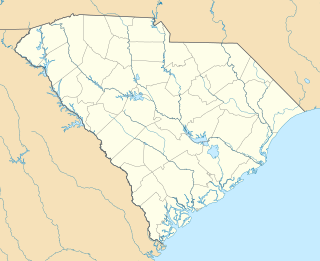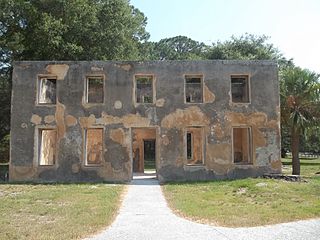 W
WThe Abraham Manee House, also known as the Manee-Seguine Homestead, is a three-part Colonial Dutch dwelling on Staten Island in New York. It was designated a New York City landmark in 1984. Located on Purdy Place adjacent to Lemon Creek, on the South Shore of Staten Island, the oldest section is a one-room structure built by Paulus Regrenier in 1670, a French Huguenot fleeing religious persecution in Europe. The building is similar to the Billiou-Stillwell-Perine House in Old Town.
 W
WDungeness on Cumberland Island, Georgia, is a ruined mansion that is part of a historic district that was the home of several families significant in American history. James Oglethorpe first built on Cumberland Island in 1736, building a hunting lodge that he named Dungeness. Oglethorpe named the place after Dungeness, on the south coast of England. Dungeness was next the legacy of Revolutionary War hero Nathanael Greene, who had acquired 11,000 acres (45 km2) of island land in exchange for a bad debt. In 1803, his widow Catharine Littlefield Greene built a four-story tabby mansion over a Timucuan shell mound. During the War of 1812 the island was occupied by the British, who used the house as a headquarters.
 W
WIsaac Fripp House Ruins is a historic house ruin and archaeological site located on Saint Helena Island near Frogmore, Beaufort County, South Carolina. The ruins are located at Bay View overlooking the junction of Chowan Creek and the Beaufort River. The two-story, tabby house dates to the early- to mid-19th century. It is associated with Isaac Fripp, a planter of sea island cotton and other staples on St. Helena Island.
 W
WThe Judah P. Benjamin Confederate Memorial at Gamble Plantation Historic State Park, also known as the Gamble Mansion or Gamble Plantation, is a Florida State Park, located in Ellenton, Florida, on 37th Avenue East and US 301. It is home to the Florida Division United Daughters of the Confederacy (UDC).
 W
WHorton House is a historic site on Riverview Drive in Jekyll Island, Georgia.
 W
WThe Island Hotel is a historic building in Cedar Key, Florida, located at 224 2nd Street. On November 23, 1984, it was added to the U.S. National Register of Historic Places.
 W
WKingsley Plantation is the site of a former estate in Jacksonville, Florida, that was named for an early owner, Zephaniah Kingsley, who spent 25 years there. It is located at the northern tip of Fort George Island at Fort George Inlet, and is part of the Timucuan Ecological and Historic Preserve managed by the U.S. National Park Service.
 W
WThe McIntosh Sugarworks, near St. Marys, Georgia, was built in the late 1820s by John Houstoun McIntosh. They are a significant example of tabby concrete architecture and represent an industrial component of southeastern plantation agriculture. The Tabby Ruins, as they are also known, are at 3600 Charlie Smith Sr. Highway at Georgia Spur 40, six miles north of St. Marys. The entrance is approximately across the street from the entrance to the Naval Submarine Base Kings Bay, on Charlie Smith Highway, at 30.79310°N 81.57712°W.
 W
WThe Naples Historical Society's Historic Palm Cottage is a historic home in Naples, Florida. It is located in the Naples Historic District.
 W
WRiverside Plantation Tabby Ruins is a historic archeological site located on Saint Helena Island near Frogmore, Beaufort County, South Carolina. The ruins are significant as an example of early- to mid-19th century tabby construction. The ruins are the remains of an outbuilding associated with the Riverside Plantation and have great archaeological potential.
 W
WSams Plantation Complex Tabby Ruins is a historic plantation complex and archaeological site located at Frogmore, Beaufort County, South Carolina. The site, possibly built upon and occupied well before 1783. It includes the ruins and/or archaeological remains of at least 12 tabby structures. They include the main plantation house, a rectangular enclosure consisting of tabby walls, a large tabby kitchen, and five tabby slave quarters. Also on the property were a variety of tabby dependencies including a barn/stable, a smoke house or blade house, a well/dairy house, and a well. The property also includes the Sams family cemetery and Episcopal chapel enclosed by high tabby walls. Other structures include possibly an overseer's house, a granary/mill, and a tabby cotton house. During and subsequent to the American Civil War the Sams Tabby Complex was occupied by freedman. Following the Civil War the plantation house was destroyed by hurricanes.
 W
WThe Summit Plantation House is an historic building in Adams Run, South Carolina, USA. The house was built for William and Amarinthia Wilkinson in 1819. The house was listed in the National Register on July 28, 1983.
 W
WThe Tabby House is a historic site in Fernandina Beach, Florida. It is located at 27 South 7th Street. On June 4, 1973, it was added to the U.S. National Register of Historic Places. R. S. Schuyler, credited as the architect, is also listed as the architect of the nearby Fairbanks House, also built in 1885.
 W
WTabby Manse, also known as Thomas Fuller House, is a building in Beaufort, South Carolina.
 W
WWhite Hall Plantation House Ruins and Oak Avenue is a historic plantation site located near Ridgeland, Jasper County, South Carolina. The site consists of the ruins of a brick house with tabby wings and twin tabby flanking outbuildings; a tabby retaining wall; and a massive double avenue of oaks planted in the late-18th or early-19th century. The plantation house was built between 1771 and 1776, then enlarged between 1786 and 1791. The house at White Hall burned about 1870 and was not renovated or occupied afterward.